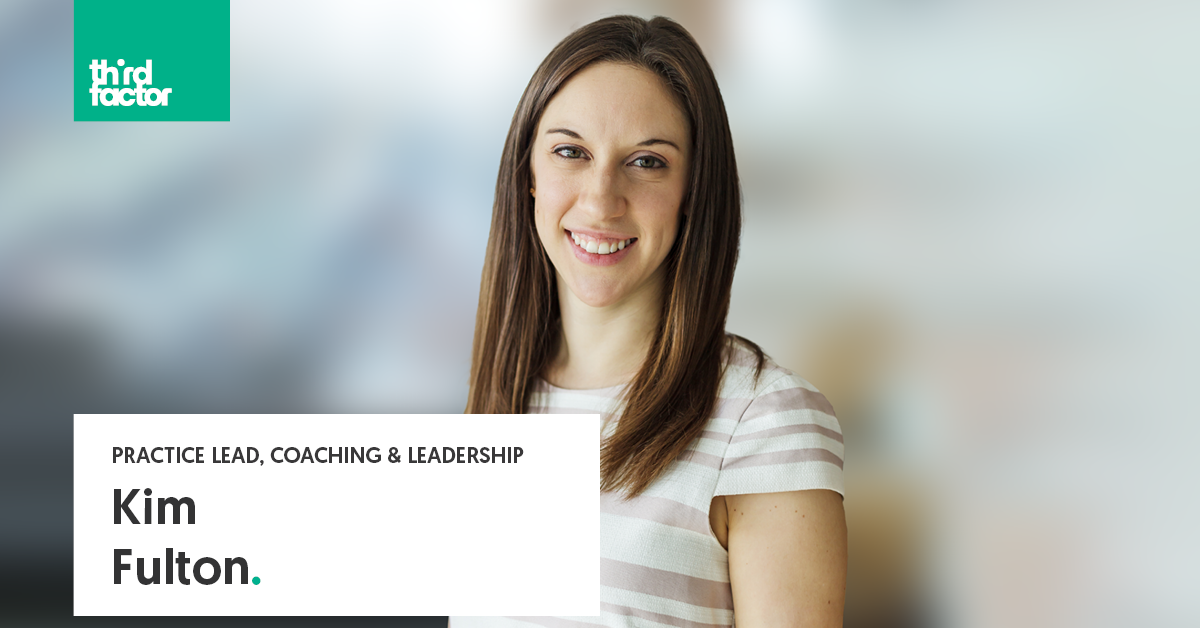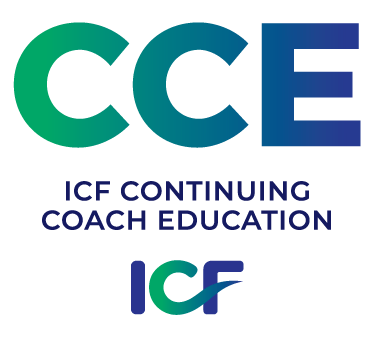As our business continues to grow, we are very excited to welcome Kim Fulton to the team to lead our coaching and leadership practice.
 Third Factor has been teaching coaching skills to managers for 30 years, since our Founders Peter Jensen and Sandra Stark pioneered the application of the principals they were observing in their work with Olympic coaches to the corporate world. Rooted in our best-in-class 3×4 Coaching model, our suite of coaching programs have helped tens of thousands of leaders become better coaches. I can’t think of anyone more perfectly suited to continue this tradition of excellence than Kim.
Kim joins us from the consulting firm, Kearney, where she created and led the firm’s employee experience centre of expertise. As part of this role, she established Kearney’s thought leadership in the employee experience space and developed new product offerings to help organizations reimagine work from an employee-centric perspective.
Kim also brings expertise in, and passion for, diversity, equity and inclusion (DEI) initiatives. She’ll be drawing on her experience working with Catalyst, a leading voice in DEI, and as the leader of Kearney’s Women’s Network, to ensure our coaching and leadership programs continue to lead the way when it comes to inclusivity.
Kim not only earned her MBA from the Smith School of Business at Queen’s University, but graduated at the top of her class. She now serves on the Advisory Board for the Full-Time MBA.
Welcome to the Third Factor team, Kim. We can’t wait to see how our programs will benefit from your passion and expertise. We’re excited to announce that we have received accreditation from the International Coaching Federation (ICF) for our flagship coaching program, 3×4 Coaching.
Third Factor has been teaching coaching skills to managers for 30 years, since our Founders Peter Jensen and Sandra Stark pioneered the application of the principals they were observing in their work with Olympic coaches to the corporate world. Rooted in our best-in-class 3×4 Coaching model, our suite of coaching programs have helped tens of thousands of leaders become better coaches. I can’t think of anyone more perfectly suited to continue this tradition of excellence than Kim.
Kim joins us from the consulting firm, Kearney, where she created and led the firm’s employee experience centre of expertise. As part of this role, she established Kearney’s thought leadership in the employee experience space and developed new product offerings to help organizations reimagine work from an employee-centric perspective.
Kim also brings expertise in, and passion for, diversity, equity and inclusion (DEI) initiatives. She’ll be drawing on her experience working with Catalyst, a leading voice in DEI, and as the leader of Kearney’s Women’s Network, to ensure our coaching and leadership programs continue to lead the way when it comes to inclusivity.
Kim not only earned her MBA from the Smith School of Business at Queen’s University, but graduated at the top of her class. She now serves on the Advisory Board for the Full-Time MBA.
Welcome to the Third Factor team, Kim. We can’t wait to see how our programs will benefit from your passion and expertise. We’re excited to announce that we have received accreditation from the International Coaching Federation (ICF) for our flagship coaching program, 3×4 Coaching.
 Based in our thirty years of working with great coaches, 3×4 Coaching teaches the 3 plays and 4 skills that exceptional coaches use to deliver results and build commitment. We’ve delivered 3×4 Coaching to thousands of leaders across hundreds of organizations ranging from tech startups to one of the world’s largest banks.
As the leading global organization for coaches and coaching, the ICF sets the gold standard for coaching education. This accreditation demonstrates that 3×4 Coaching meets the highest standards in coaching professional development, meeting the ICF’s strict educational and ethical requirements.
ICF-credentialed coaches who complete 3×4 Coaching in its 2-day classroom or virtual learning journey formats will earn a total of 12 CCE credits that may be used when renewing their credential. Coaches who complete the 1-day classroom workshop will earn 7 CCE credits. Click here to find details on our upcoming open enrollment programs.
Learn more about the ICF Continuing Coach Education (CCE) accreditation and standards at their website. We are thrilled to announce that we have been awarded four Brandon Hall Group Excellence Awards alongside our partners, Bayer and SweetRush.
Based in our thirty years of working with great coaches, 3×4 Coaching teaches the 3 plays and 4 skills that exceptional coaches use to deliver results and build commitment. We’ve delivered 3×4 Coaching to thousands of leaders across hundreds of organizations ranging from tech startups to one of the world’s largest banks.
As the leading global organization for coaches and coaching, the ICF sets the gold standard for coaching education. This accreditation demonstrates that 3×4 Coaching meets the highest standards in coaching professional development, meeting the ICF’s strict educational and ethical requirements.
ICF-credentialed coaches who complete 3×4 Coaching in its 2-day classroom or virtual learning journey formats will earn a total of 12 CCE credits that may be used when renewing their credential. Coaches who complete the 1-day classroom workshop will earn 7 CCE credits. Click here to find details on our upcoming open enrollment programs.
Learn more about the ICF Continuing Coach Education (CCE) accreditation and standards at their website. We are thrilled to announce that we have been awarded four Brandon Hall Group Excellence Awards alongside our partners, Bayer and SweetRush.
 The awards are a result of our participation in Bayer’s innovative Rise and Thrive program, a microlearning experience based on the idea that if you have two minutes, you have enough time to become a stronger, more empathetic, more inclusive leader. The experience comprises bite-sized content including short videos, curated articles, and 2-minute “dares.”
Rise and Thrive was pioneered by Bayer’s U.S. Learning Lead, Renee Landry, and Senior Leadership Expert, Rachel Lamb. The interactive experience was developed by e-learning development company SweetRush and supported with video and learning content by Third Factor.
Approximately half of Bayer’s 4,000 US leaders voluntarily participated in the program, which has received outstanding quantitative and qualitative feedback from participants as well as attention from the broader learning industry.
The awards include:
The awards are a result of our participation in Bayer’s innovative Rise and Thrive program, a microlearning experience based on the idea that if you have two minutes, you have enough time to become a stronger, more empathetic, more inclusive leader. The experience comprises bite-sized content including short videos, curated articles, and 2-minute “dares.”
Rise and Thrive was pioneered by Bayer’s U.S. Learning Lead, Renee Landry, and Senior Leadership Expert, Rachel Lamb. The interactive experience was developed by e-learning development company SweetRush and supported with video and learning content by Third Factor.
Approximately half of Bayer’s 4,000 US leaders voluntarily participated in the program, which has received outstanding quantitative and qualitative feedback from participants as well as attention from the broader learning industry.
The awards include:
- Gold: Best Advance in Custom Content
- Gold: Best Unique or Innovative Learning and Development Program
- Gold: Best Use of Video for Learning
- Silver: Best Unique or Innovative Leadership Program
Brandon Hall Group is a research and analyst firm with a mission to empower excellence in organizations around the world. The Excellence Awards recognize the best organizations that have successfully deployed programs, strategies, modalities, processes, systems, and tools that have achieved measurable results. All of this year’s winners can be found on the Brandon Hall Group website. If you’ve read Dane Jensen’s book, The Power of Pressure, you may have enjoyed the title of Chapter 9: Sleep and Other Inconvenient Necessities.
Like it or not, downtime is essential for performance under pressure over the long haul. High performers prioritize sleep, nutrition, and breaks to stay fresh and energized. That’s why we’re always excited to share our summer reading list: there’s no better break than some time off over the summer with a good book.
Whether you want to learn something new or veg out with an easy read, you’ll find your perfect summer book on this list. Here’s what our team recommends for 2022.
Peggy Baumgartner, Chief Learning Officer
The Power of Regret by Daniel Pink
When people ask me what about my regrets in life, I always say I have none. Yet Daniel Pink's research points to regret bringing clarity, meaning and focus to all that is important to a person. My flip answer of ‘no regrets’ reflects my optimistic personality, and this summer I will get a little more curious about the value of digging a little deeper to see what I can learn. I would love to hear from others who explore this ‘new to me’ emotion.
Easily my most gifted book of the past year, Why We Sleep is a tour de force exploration of the nature, benefits, and challenges of sleep. The research Walker cites is profound and varied, and the way he presents it is engaging, accessible and actionable. Whether you are looking for the motivation to commit to more sleep or strategies to sleep longer or better, you’ll find it in here. Plus, as a bonus, it’s the only book I’ve read where the author actually encourages you to fall asleep while reading.
While it appears to be a book about finance, this book uses stories about people and money as a way of illustrating the real world dynamics of human behaviour. The content is entertaining, the writing clear and the insights well worth pondering.
While this book has Alzheimer’s prevention at its heart, it’s a powerful read for anyone who wants to “do good” for their brain to improve memory, prevent cognitive decline, and eliminate brain fog. Packed with tons of practical information backed by research, this is an easy-to-read perspective on how we help our most vulnerable organ (the brain) by digging deep into the fat, protein, carbs, sugars, vitamins, and minerals it needs to function optimally.
I borrowed this book from a friend around a decade ago and never gave it back, with good reason. Dr. Posen breaks down stress using simple stories, relevant information, and a few hard truths. The book is divided into 52 (mercifully short) chapters, each ending with a highly actionable "prescription" to help you convert the concepts into action and make small changes that add up to a much healthier relationship with life's demands.
Where the Crawdads Sing (Recommended by Reese’s Book Club and my Hockey Moms Book Club) is about Kya Clark, an isolated, abandoned “Marsh Girl” who is educated in the swamps of North Carolina living deep with nature. A coming-of-age novel that covers prejudice, friendship, solitude, desertion, and education, the narrative is as rich as the setting Owens describes. Make sure to read it before the motion picture comes out this summer.
My pick provides a fascinating look at how you can apply design thinking to your own life to create options, possibilities, and a mindset that allows you to craft a life well-lived. Haven’t been to design school? Don’t see yourself as a creative person? No problem. Get this book, grab a notepad, and be ready to think outside the box, because Bill and Dave will take you step by step through a series of exercises that will get you thinking like a designer to solve problems and mental blocks, brainstorm the “many lives” you could live productively and happily, then choose the one that speaks to you most. Happy summer reading!
This is a fun history book about film, music, sports, politics, culture, global events, and the momentum of the internet. If you are interested in reliving the nineties in an unconventional manner, this is a terrific read. Chuck Klosterman writes with engaging insight and humor that will evoke both memories and questions and explains things I wasn't able to explain for myself.
For those who love historical novels with a twist, this is a fabulous read. It is the story of a young, bright woman with a restless spirit who rebels against the mores of her time. Sue Monk is a daring woman herself as she introduces Jesus who meets up with this young woman when they are both older teenagers and marries her. It is a marriage of convenience that serves both well. The writing is grounded in meticulous research and written with a reverential approach to Jesus’ life that focuses on his humanity. And it is an inspiring and unforgettable account of one woman’s bold struggle to realize her own potential in a dangerous time for women to speak up. More than that, it is just great story telling and good writing. I love learning about historical periods in this way. Enjoy.
Alexis Ullerick, Program Logistics Lead
The Productivity Project by Chris Bailey
My pick synthesizes the findings of the author’s year long project to become as productive as possible. Grounded in the concept that productivity comes from managing your time, attention, and energy, Bailey shares his year long journey of productivity experiments like getting up at 5:30 every morning, cutting out caffeine, becoming more intentional and deliberate in his work, and so many more. Each chapter includes a challenge to implement his insights into your own life. Chris Bailey’s writing is fun and witty! When I finished the book I felt like I’d gained a year’s worth of knowledge in just a few days, which already had me feeling pretty productive!
Many websites use affiliate links to make money when you buy something from Amazon – we don’t. Feel free to follow the links provided or pick up the book you want from your favourite local bookseller. Prior to now, hybrid working environments have never existed on a wide-scale basis. With few proven best practices to rely on, you need to work together with your team to create a new playbook for how to get the best out of the team and its individual members.
By necessity, this involves a lot of experimentation. To capture the lessons from these experiments, it will be essential that your people are willing to ask questions to gain clarity, share ideas on how to do things differently, and voice concerns when things aren’t on track. And this can only happen if your team members believe they are safe to do so.
Unfortunately, biology is not on your side. By default, people want to avoid looking ineffective or incapable to their leader. To foster psychological safety on your team, it’s not enough to encourage your people to speak up. You need to consistently demonstrate that it’s expected, appreciated, and rewarded.
Level the playing field
Like it or not, your people are hard-wired to view you as a threat. The amygdala, sometimes referred to as our “lizard brain,” is constantly scanning the environment for threats – and, according to Your Brain at Work author, Dr. David Rock, social threats like an imbalance of power are no exception. As much as you tell your people they can be honest with you, the amygdala will override the logical part of the brain until it has witnessed a pattern of behaviour consistently enough to convince it you’re not a threat.
“Telling people to speak their mind won’t yield any results if they haven’t seen a predictable pattern of behaviour from you that it’s safe to do so.”
In other words, telling people to speak their mind won’t yield any results if they haven’t seen a predictable pattern of behaviour from you that it’s safe to do so. You have to show them, over and over again, that the only thing that will result is a better work environment.
To sow the seeds of psychological safety, you need to set clear expectations with your team, ask for specific input on a regular basis, and practice responding positively – even when you don’t like what you hear, the timing is bad or the input is delivered in a way that triggers you.
Change the frame
People are unlikely to speak their mind when given a vague invitation for feedback. Consider the response you get when you ask someone “How are you?” Most of the time the reply is some version of “Busy but good.” or “Could be worse.”
Change the frame by explicitly stating that as the team adapts to a hybrid model, there will be much to learn and it is critical that everyone shares what is going on from their point of view. Emphasize that for the team to be successful, people need to speak up. Be clear that the expectation is that people will share ideas, ask questions, voice concerns, and admit mistakes.
“Be clear that the expectation is that people will share ideas, ask questions, challenge consensus, and admit mistakes.”
Walk the talk
After framing the expectation, reinforce it by consistently asking people for input. Instead of asking “any questions?”, which tends to garner nodding heads and silence, ask a variety of specific questions to surface where people are at.
- “Vikram, what do you see as the most challenging part of this?”
- “Alexis, you’ve been quiet, what are your thoughts on this approach?”
- “Jordan, how might this group support you in completing your task?”
Recognize the effort and impact
When people do voice their opinion, reinforce that behaviour by specifically describing what they’ve done right, illustrating the behaviour’s positive impact, and expressing appreciation for the effort. When it’s warranted, be sure to acknowledge the emotional component as well.
- “Natasha, asking for help kept the project on track and saved Peggy’s team from having to work late. Keep it up.”
- “Soheli, your idea led to a great discussion that got the whole team engaged. Keep them coming.”
- “Darren, it took a lot of courage to bring this to my attention and I really appreciate it. What can I do to help you move forward?”
Manage your outside voice
In some cases, encouraging this behaviour might be difficult. Suppose that you are just wrapping up a planning meeting at one of your in-person days in the office when Janelle excitedly suggests a new approach. Aside from the terrible timing, the idea itself raises huge red flags for you.
Internally you might be thinking “going that route would be a complete disaster!” But if your inside voice becomes your outside voice, you’ve just made the environment a little less safe for people to provide input.
To help you convey that input is welcome, even in moments when you’ve been triggered, a simple 3 step process can help.
- Pause: take a moment to breathe and ask yourself what the moment needs from you.
- Acknowledge: a simple thanks is often enough.
- Respond: in most cases you will need to get more clarity, provid clarity, or delay the matter and revisit later.
They’ll believe it when they see it
When people feel safe to share ideas, voice concerns, admit mistakes and ask questions, you have better access to the information you need to keep your team on a path to high performance. Foster psychological safety on your team by framing input as essential to success, asking for the input you need, and recognizing your people for doing the right thing.
Learn skills for leading in a hybrid world
Leaders who are able to leverage the advantages and mitigate the challenges of hybrid work will build high-performing teams at a time when engagement and commitment are at risk.
Learn practical skills for leading hybrid teams in our program, Leading in a Hybrid World.
As in many sports, when navigating uncertainty it helps to “look where you want to go.” In his latest article for HBR, Third Factor CEO, Dane Jensen, outlines a process for imagining a plausible, positive version of the future and taking steps to actually get there.
Read the article at HBR.org. Our company’s roots go back to the 1988 Olympic Games in Calgary, Alberta. Our founders, Peter Jensen and Sandra Stark, were mental performance coaches to Canada’s figure skating team – a team that won 3 out of Canada’s 5 medals on home soil. The business community took notice, and Peter and Sandra were soon working with organizations across the country to apply the principles they used in sport to a wide variety of other settings.
Fast forward to 2022 and Olympic Sport is still our top R&D lab. We work with athletes and coaches at the highest level to understand how they perform, collaborate and lead, and synthesize their best practices for use across disciplines – from business, to academia, industry, philanthropy and beyond.
We’ve had the privilege of working with dozens of athletes and coaches who are representing Canada at the Beijing Games. Here’s a roundup of who we’ll be cheering for this February.
The Canadian Ski Team
Ski Cross is one of the most exciting freestyle skiing events at the Games. We’ve been proud to work with the athletes and coaches on both the men’s and women’s teams to help them build self-awareness, leverage their strengths, and perform under pressure. We’ll be cheering them on in the Ski Cross events on February 17th & 18th.
Our work with Alpine Canada has also taken us to the downhill skiing events. We’ll be keeping a close eye on Team Canada at the men’s and women’s Slalom, Giant Slalom, and Super-G events.
Figure skaters from around the world
Brian Orser and Tracy Wilson are not just Olympic medallists, but widely regarded as the top coaches in the sport. They’ve shared their perspectives on performing in critical moments with us, and we’ll be cheering on their skaters as they compete for the podium in Beijing.
 Tracy Wilson is an Olympic Medallist and 7-time Canadian champion
Tracy Wilson is an Olympic Medallist and 7-time Canadian champion
The Canadian Women’s Hockey Teams
We’ll be staying up late to watch Team Canada battle to reclaim Gold. We’ll also be keeping our eye Marie-Philip Poulin who is not just one of the best pressure performers in the world, but the best hockey player in the world, full stop according to our co-founder Peter Jensen. Imagine you’re organizing an in-person learning event for a group of 30 senior leaders. You’ve spent weeks getting the details just right. It’s the first time this group will be getting together in over two years, and you can’t wait for two days of interactive, collaborative learning.
And then, the calls start to come in. One week out from the event, the head of marketing tells you there is a case of Covid-19 in her daughter’s classroom, and she will need to attend the session remotely to keep her in self-isolation. Then, three days before, two more calls come from sales leaders who need to travel to meet with clients and will need to participate remotely.
In a matter of days, 10% of your group needs to attend remotely. More requests are sure to come in, and your team now needs to come up with a way to accommodate both in-person and remote learners on short notice.
This is the new reality. The question is no longer whether to deliver learning remote or in-person – but rather whether to be fully remote or to host a hybrid learning experience. By assuming all in-person events will need to accommodate remote participants – and planning accordingly – you can create learning experiences that are ready to adapt to whatever may come.
Hybrid is to Netflix as in-person is to Blockbuster
Hybrid learning events struggle to achieve their goals when they’re treated as an in-person experience first. But as many industries have learned the hard way when undergoing disruption, you can’t do what you’ve always done and expect the same results. Much as Blockbuster failed to recognize Netflix as a serious disruptor, learning organizations stand to fail by ignoring the importance and permanence of hybrid learning.
Much as Blockbuster failed to recognize Netflix as a serious disruptor, learning organizations stand to fail by ignoring the importance and permanence of hybrid learning.
When L&D professionals do as Blockbuster did and try to carry on with business as usual, the result is a poor experience. The overarching problem is the lack of interactivity between in-person and remote participants, resulting from poorly adapted technology and resources, limited opportunities for participants to connect with each other, and a failure of the event organizers and facilitators to understand participants ahead of time.
At the heart of solving these problems before they happen is a focus on creating a unified experience for all learners. Successful hybrid learning events do this by giving careful consideration to how technology is used, creating opportunities for participants to connect, and getting to know participants ahead of time. In delivering hybrid learning to our clients, we’ve observed some innovative practices that exemplify this philosophy.
Adapt technology to the human experience – not vice-versa
Inequality in hybrid learning environments often results when the human element is considered secondarily to technology. For example, remote participants suffer when their experience is made possible by a laptop placed near the front of the room. Thoughtful hybrid learning design considers the desired experience first and then uses technology to build quality and efficiency, creating a “one-classroom” model where all participants feel included and barriers to communication are removed.
Bring the online experience into the room
One of our clients, a major quick-service restaurant chain, added a screen at the front of the room displaying the online experience. This ensured everyone in the room, including the facilitator and participants, were constantly aware of the people who weren’t physically present.
Create a screen-friendly experience for online participants
In early 2020, our partners in the Full-Time MBA program at the Smith School of Business at Queen’s University found a way for remote learners to experience the class in the same way as the in-person cohort by hiring a full-time videographer. As the approach has proven successful, the program is now leveraging technology to deliver the experience more efficiently with an automated system.
As a low-cost alternative, the quick-service restaurant chain asked in-person participants to bring their laptops and join the online meeting, keeping their cameras on so remote participants could see faces and hear comments. An AV support team set up microphones at every table to ensure remote participants could hear discussions clearly and both the in-person and remote conversations were moderated. We like this approach enough that we’ve adopted it for our own hybrid staff meetings – with great success.
Have support to bridge the gap
The Smith MBA program addressed cross-medium communication challenges by placing a staff member in each classroom to act as a moderator, managing the incoming Zoom information and filtering it to the faculty to ensure the remote participation was managed efficiently.
Create opportunities for participants to connect with each other
What we know as we gain more experience through this hybrid world is that people are craving more opportunities to connect on both a personal and professional level with their colleagues – a part of the experience that’s often neglected for online participants.
At larger events, we’ve seen this solved with formalized “brain dates” in which participants have scheduled time to meet one-on-one or in a small group, and indicate their preference to meet live, online, or hybrid. Meetings can be on a subject relevant to the event or less-formal opportunities for networking.
Our team at Third Factor has addressed this by scheduling a regular meeting with cameras on to share from our learning experiences and connect about what’s happening at a personal and professional level. We don’t just stop there though, many of us set up informal coffee chats to reconnect with each other, have a laugh, and sometimes we actually have a coffee!
Understand the field before playing the game
In our 3×4 Coaching program, we teach that people can’t commit without having clarity on what’s expected and why it matters. Successful hybrid learning events require the organizers and facilitators to have clarity on who the participants are and what their needs are.
One of our favorite ways of building clarity comes from the legendary basketball coach Jack Donohue, who would ask: “what would you see,” and “what would you hear.” I.e., what would you see and hear if you were a remote participant having a positive, engaging experience?
The Smith MBA Program called this “understanding the field before playing the game.” The instructor got to know remote participants’ names and locations ahead of time, and was able to use that information to engage them – acknowledging them personally and asking questions of them throughout the session.
Keep your eyes wide open
As Albert Einstein said, “you can’t use an old map to explore a new world.” To execute successful hybrid learning events, learning & development teams need to recognize that the choice isn’t between remote and in-person learning; it’s between remote and hybrid.
Every in-person event will inevitably need to accommodate remote participants, at least in the near-future. To ensure your next learning event is successful, this shift in designing your learning experiences will require thoughtful planning to put the human experience ahead of technology, create opportunities for participants to connect with each other, and get to know your participants ahead of time so everyone can be included.
 Third Factor has been teaching coaching skills to managers for 30 years, since our Founders Peter Jensen and Sandra Stark pioneered the application of the principals they were observing in their work with Olympic coaches to the corporate world. Rooted in our best-in-class 3×4 Coaching model, our suite of coaching programs have helped tens of thousands of leaders become better coaches. I can’t think of anyone more perfectly suited to continue this tradition of excellence than Kim.
Kim joins us from the consulting firm, Kearney, where she created and led the firm’s employee experience centre of expertise. As part of this role, she established Kearney’s thought leadership in the employee experience space and developed new product offerings to help organizations reimagine work from an employee-centric perspective.
Kim also brings expertise in, and passion for, diversity, equity and inclusion (DEI) initiatives. She’ll be drawing on her experience working with Catalyst, a leading voice in DEI, and as the leader of Kearney’s Women’s Network, to ensure our coaching and leadership programs continue to lead the way when it comes to inclusivity.
Kim not only earned her MBA from the Smith School of Business at Queen’s University, but graduated at the top of her class. She now serves on the Advisory Board for the Full-Time MBA.
Welcome to the Third Factor team, Kim. We can’t wait to see how our programs will benefit from your passion and expertise. We’re excited to announce that we have received accreditation from the International Coaching Federation (ICF) for our flagship coaching program, 3×4 Coaching.
Third Factor has been teaching coaching skills to managers for 30 years, since our Founders Peter Jensen and Sandra Stark pioneered the application of the principals they were observing in their work with Olympic coaches to the corporate world. Rooted in our best-in-class 3×4 Coaching model, our suite of coaching programs have helped tens of thousands of leaders become better coaches. I can’t think of anyone more perfectly suited to continue this tradition of excellence than Kim.
Kim joins us from the consulting firm, Kearney, where she created and led the firm’s employee experience centre of expertise. As part of this role, she established Kearney’s thought leadership in the employee experience space and developed new product offerings to help organizations reimagine work from an employee-centric perspective.
Kim also brings expertise in, and passion for, diversity, equity and inclusion (DEI) initiatives. She’ll be drawing on her experience working with Catalyst, a leading voice in DEI, and as the leader of Kearney’s Women’s Network, to ensure our coaching and leadership programs continue to lead the way when it comes to inclusivity.
Kim not only earned her MBA from the Smith School of Business at Queen’s University, but graduated at the top of her class. She now serves on the Advisory Board for the Full-Time MBA.
Welcome to the Third Factor team, Kim. We can’t wait to see how our programs will benefit from your passion and expertise. We’re excited to announce that we have received accreditation from the International Coaching Federation (ICF) for our flagship coaching program, 3×4 Coaching.

 The awards are a result of our participation in Bayer’s innovative Rise and Thrive program, a microlearning experience based on the idea that if you have two minutes, you have enough time to become a stronger, more empathetic, more inclusive leader. The experience comprises bite-sized content including short videos, curated articles, and 2-minute “dares.”
Rise and Thrive was pioneered by Bayer’s U.S. Learning Lead, Renee Landry, and Senior Leadership Expert, Rachel Lamb. The interactive experience was developed by e-learning development company SweetRush and supported with video and learning content by Third Factor.
Approximately half of Bayer’s 4,000 US leaders voluntarily participated in the program, which has received outstanding quantitative and qualitative feedback from participants as well as attention from the broader learning industry.
The awards include:
The awards are a result of our participation in Bayer’s innovative Rise and Thrive program, a microlearning experience based on the idea that if you have two minutes, you have enough time to become a stronger, more empathetic, more inclusive leader. The experience comprises bite-sized content including short videos, curated articles, and 2-minute “dares.”
Rise and Thrive was pioneered by Bayer’s U.S. Learning Lead, Renee Landry, and Senior Leadership Expert, Rachel Lamb. The interactive experience was developed by e-learning development company SweetRush and supported with video and learning content by Third Factor.
Approximately half of Bayer’s 4,000 US leaders voluntarily participated in the program, which has received outstanding quantitative and qualitative feedback from participants as well as attention from the broader learning industry.
The awards include:
 Tracy Wilson is an Olympic Medallist and 7-time Canadian champion
Tracy Wilson is an Olympic Medallist and 7-time Canadian champion




















